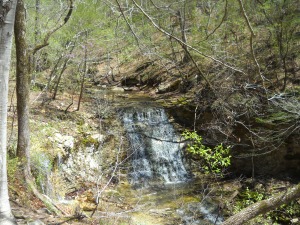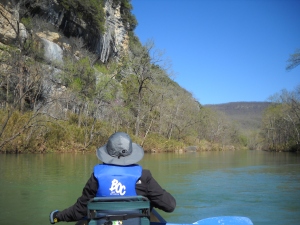 Warm, sunny, and a clear sky, Tuesday, April 15 is a perfect spring day to begin a four-day, three-night canoe paddle of the Buffalo National River. Putting in at Ponca and taking out at
Warm, sunny, and a clear sky, Tuesday, April 15 is a perfect spring day to begin a four-day, three-night canoe paddle of the Buffalo National River. Putting in at Ponca and taking out at 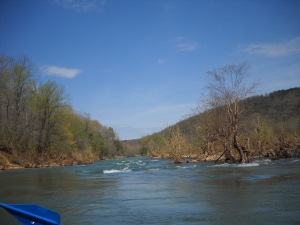 Woolum, Stephen and I have planned a fifty-mile float. With Class I and II rapids and a moderate current, we plan on averaging two miles an hour, a typical average for the Buffalo. Loading the canoe at Ponca, I eyeball the rapids feeling a mixture of trepidation and excitement. This is my first experience with canoes on whitewater, but I have faith in my husband’s river skills. The first day we gain our river bearings and increase our confidence as we easily conquer rapids with names such as Roark Bluff, Big Bluff, and Gray Rock. We discover a picnic spot with three rock “chairs” and two rock “tables”. A perfect place to prepare lunch: olive pate with crackers. I am experimenting with dehydrating my own meals and am building a backcountry pantry at home. Lunch is a delicious success! The olive pate rehydrated well and was delicious served on Ritz crackers.
Woolum, Stephen and I have planned a fifty-mile float. With Class I and II rapids and a moderate current, we plan on averaging two miles an hour, a typical average for the Buffalo. Loading the canoe at Ponca, I eyeball the rapids feeling a mixture of trepidation and excitement. This is my first experience with canoes on whitewater, but I have faith in my husband’s river skills. The first day we gain our river bearings and increase our confidence as we easily conquer rapids with names such as Roark Bluff, Big Bluff, and Gray Rock. We discover a picnic spot with three rock “chairs” and two rock “tables”. A perfect place to prepare lunch: olive pate with crackers. I am experimenting with dehydrating my own meals and am building a backcountry pantry at home. Lunch is a delicious success! The olive pate rehydrated well and was delicious served on Ritz crackers.
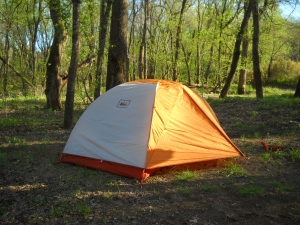 Either we paddle a lot or the river is moving fast. Or we paddle a lot AND the river is moving fast. We arrive at our first night’s destination, Kyles Landing, way earlier than expected. Kyles Landing is a developed national park campground with flush toilets and water. After discussing the time, Stephen and I decide to paddle a little further down river and camp for free somewhere along the bank. The park service allows camping anywhere along the river, no permit necessary. Stephen and I practice Leave No Trace principles and focus on low-impact camping so we are prepared for a primitive camp. Plus, unsure of the rain situation in the upcoming days, we don’t want to waste beautiful daylight! We paddle until 5:30 and find a great campsite alongside the river. We make camp and cook dinner. I should have rehydrated dinner at lunch. The Chana Masala is a little crunchy. Oh well, I’m learning.
Either we paddle a lot or the river is moving fast. Or we paddle a lot AND the river is moving fast. We arrive at our first night’s destination, Kyles Landing, way earlier than expected. Kyles Landing is a developed national park campground with flush toilets and water. After discussing the time, Stephen and I decide to paddle a little further down river and camp for free somewhere along the bank. The park service allows camping anywhere along the river, no permit necessary. Stephen and I practice Leave No Trace principles and focus on low-impact camping so we are prepared for a primitive camp. Plus, unsure of the rain situation in the upcoming days, we don’t want to waste beautiful daylight! We paddle until 5:30 and find a great campsite alongside the river. We make camp and cook dinner. I should have rehydrated dinner at lunch. The Chana Masala is a little crunchy. Oh well, I’m learning.
After a beautiful warm day in the low 70s, as soon as the sun dips below the bluff, the air begins to chill. Time to go to bed. Dressed in a long-sleeved SmartWool shirt, long underwear, SmartWool socks, and snuggled down deep in the sleeping bag, I freeze. My toes are like ten ice cubes attached to two feet. I doze and wait for morning and the warmth of the sun’s rays. Of course Stephen sleeps well, as usual. I wake him every so often to let him know that I am very, very cold. He snuggles close and promises tomorrow will be another beautiful sunny day.
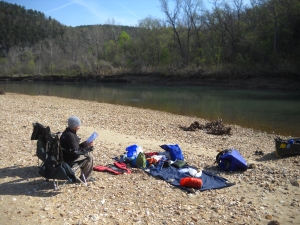 And he was right! Wednesday is sunny and warm. However, it is also windy. The rapids present a different kind of challenge in the wind. I continue to paddle hard and Stephen does an excellent job keeping the nose of the canoe into the wind. Today we have to paddle a lot because even in the calm sections the wind is stronger than the current and pushes us towards shore. As a result of all the paddling, we make excellent time, paddling 20 miles before evening. We choose a campsite on a rocky beach with a soft sandy section for our tent. We prepare dinner (an excellent vegetarian curry stew) and enjoy every drop of sunshine left in the day. Tonight is cold, but after a hard day of paddling I am exhausted enough to sleep a little better. Again, Stephen sleeps really well and I don’t wake him as often. After fighting those winds all day, he deserves a peaceful night.
And he was right! Wednesday is sunny and warm. However, it is also windy. The rapids present a different kind of challenge in the wind. I continue to paddle hard and Stephen does an excellent job keeping the nose of the canoe into the wind. Today we have to paddle a lot because even in the calm sections the wind is stronger than the current and pushes us towards shore. As a result of all the paddling, we make excellent time, paddling 20 miles before evening. We choose a campsite on a rocky beach with a soft sandy section for our tent. We prepare dinner (an excellent vegetarian curry stew) and enjoy every drop of sunshine left in the day. Tonight is cold, but after a hard day of paddling I am exhausted enough to sleep a little better. Again, Stephen sleeps really well and I don’t wake him as often. After fighting those winds all day, he deserves a peaceful night.
Thursday is gorgeous! Today I don’t even need to wear a jacket on the river. And no more wind. Just a peaceful current and lots of fun, rolling rapids that give a gentle push to the canoe. We decide to paddle to our final destination, Woolum, and camp there tonight, giving us a full day to travel to Hot Springs tomorrow. The Nars, or the Narrows, is definitely an unexpected highlight to our trip. The Nars is a very narrow limestone bluff with the Buffalo National River on one side and Richland Creek on the other. The currents running on both sides of the bluff has created a ridge that gets smaller as Richland Creek approaches the Buffalo River. Immediately following the Nars is Skull Bluff. Skull Bluff has the appearance of (you guessed it) a skull. If the water is low, you can paddle through the “eye”.
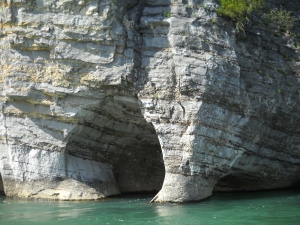 Shortly after Skull Bluff, we spy the Woolum sign on the right side of the river. This is confusing because the map indicates the take out is on the left. We beach at the sign and are delighted with a special surprise! Two days earlier, we met a wonderful couple from South Carolina also paddling a multi-day trip. This couple took the time to write a message for us in the sand. We soon realize the campground take out is on the other side, ACROSS the rapids.
Shortly after Skull Bluff, we spy the Woolum sign on the right side of the river. This is confusing because the map indicates the take out is on the left. We beach at the sign and are delighted with a special surprise! Two days earlier, we met a wonderful couple from South Carolina also paddling a multi-day trip. This couple took the time to write a message for us in the sand. We soon realize the campground take out is on the other side, ACROSS the rapids. 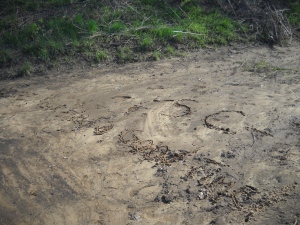 We take a deep breath, concentrate on the task, Stephen yells GO!, and we paddle hard! Very, very hard! We make it to the other side, just slightly off the mark. The timing could not have been more perfect. Just as we unload the last off our items from the canoe to a campsite up a slight hill, our car arrives. We had hired a shuttle driver to move our car from the put in to the take out. At lunch today, Stephen had enough signal to call the outfitter and let them know we are a day ahead of schedule. We decide to camp tonight in an established campground with water, toilets, and showers. We load our gear into the car and make the short drive to Tyler’s Bend campground.
We take a deep breath, concentrate on the task, Stephen yells GO!, and we paddle hard! Very, very hard! We make it to the other side, just slightly off the mark. The timing could not have been more perfect. Just as we unload the last off our items from the canoe to a campsite up a slight hill, our car arrives. We had hired a shuttle driver to move our car from the put in to the take out. At lunch today, Stephen had enough signal to call the outfitter and let them know we are a day ahead of schedule. We decide to camp tonight in an established campground with water, toilets, and showers. We load our gear into the car and make the short drive to Tyler’s Bend campground.
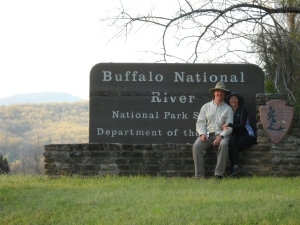 Tyler’s Bend Campground located next to the Tyler’s Bend Visitor Center on the Buffalo National River is a beautifully maintained campground with several very much appreciated amenities. Even though there are many sites available with views of the river, Stephen and I choose a site directly across from the bathrooms and set-up camp. We have had views of the river for the last two nights and decide it will be luxurious to follow a quick, lighted, paved walkway to showers and a western-style toilet that I can actually sit upon. After setting up camp, I head to the bathhouse to wash my hands before making Salmon Patties for dinner. As I approach the building, I notice…could it be?…YES! A dishwashing sink! With hot water! I run back to camp and announce my discovery to my husband. After four days of backcountry cooking following Leave No Trace principles, the sink is a very special luxury. We do not have to heat our water and we can wash our dishes using a little more suds.
Tyler’s Bend Campground located next to the Tyler’s Bend Visitor Center on the Buffalo National River is a beautifully maintained campground with several very much appreciated amenities. Even though there are many sites available with views of the river, Stephen and I choose a site directly across from the bathrooms and set-up camp. We have had views of the river for the last two nights and decide it will be luxurious to follow a quick, lighted, paved walkway to showers and a western-style toilet that I can actually sit upon. After setting up camp, I head to the bathhouse to wash my hands before making Salmon Patties for dinner. As I approach the building, I notice…could it be?…YES! A dishwashing sink! With hot water! I run back to camp and announce my discovery to my husband. After four days of backcountry cooking following Leave No Trace principles, the sink is a very special luxury. We do not have to heat our water and we can wash our dishes using a little more suds.








